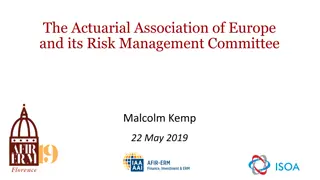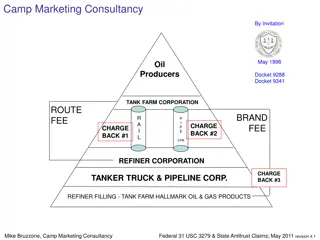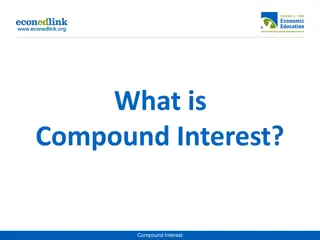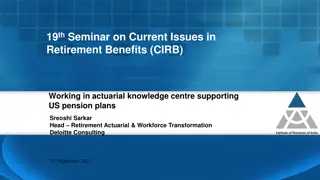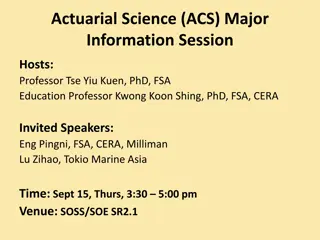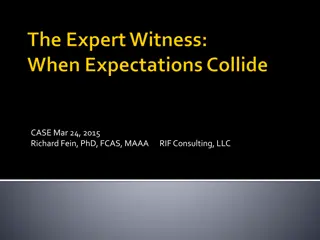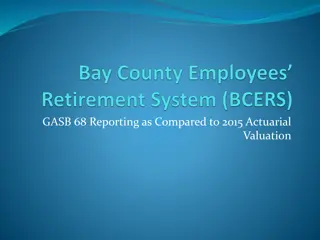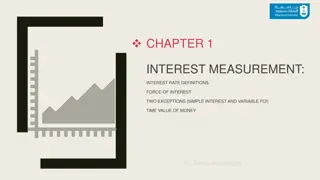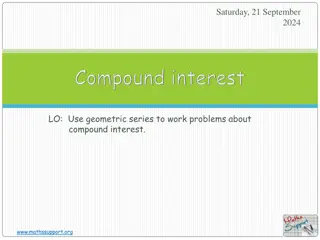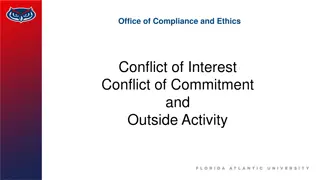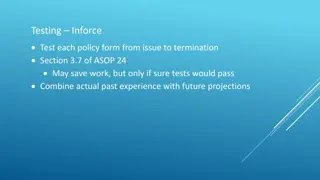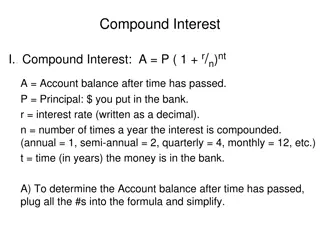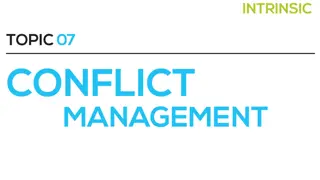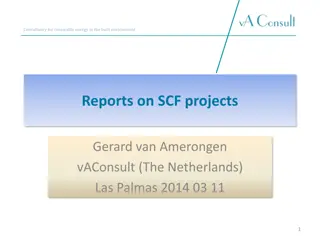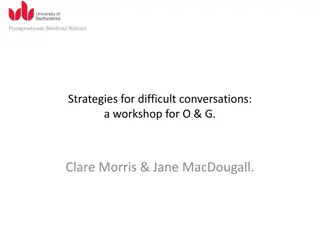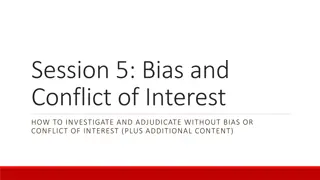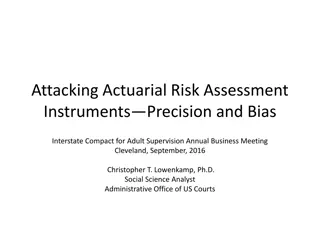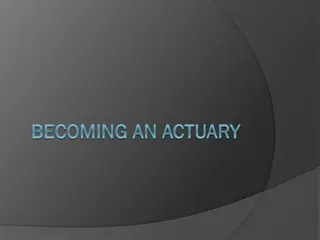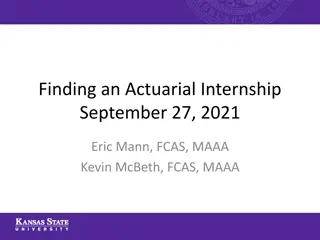Handling Conflict of Interest in Actuarial Consultancy: A Case Study
Investment consultant, a qualified actuary, faces potential conflict of interest in advising two clients involved in a management buyout. Issues arise with the Sale Purchase Agreement's ambiguity and his involvement in the buyout process. The consultant must navigate these challenges to uphold professional standards and serve both clients ethically.
Download Presentation

Please find below an Image/Link to download the presentation.
The content on the website is provided AS IS for your information and personal use only. It may not be sold, licensed, or shared on other websites without obtaining consent from the author. Download presentation by click this link. If you encounter any issues during the download, it is possible that the publisher has removed the file from their server.
E N D
Presentation Transcript
Institute of Actuaries of India Conflict in Sale and Purchase Vichitra Malhotra Ishwar Gopashetti Gopal Kumar Guide: Mayur Ankolekar Indian Actuarial Profession Serving the Cause of Public Interest
Agenda Introduction Background Situation at hand Key Issues Key Considerations Likely mistakes made? How to deal with the situation? Professional Standards to consider Professional Issues Key Professional Issues Areas for exercising caution Summary www.actuariesindia.org 2
Introduction: Background Investment Consultant, a qualified actuary, has two clients Existing Client: Trustees of Pension Fund of Company A Client A Scheme Actuary different from Investment Consultant New Client: Trustees of Pension Fund of Company B Company B to be formed from Management buyout* of Company A Client B Finance Director of Company A to be CEO and Chairman of Trustees of Company B *Management buyout involves purchasing a controlling stake in Company by its executive directors and managers Actuary agrees to be investment consultant of Company B s trustees Does not envisage being potentially involved in buyout process in any way Begins advising Client B on appropriate arrangements for new scheme / fund; everything agreed for new scheme except bulk transfer value from old scheme www.actuariesindia.org 3
Introduction: Situation at hand Receives Letter and Sale Purchase Agreement from Client B Receives letter Stating the bulk transfer value has been agreed Asking him to make arrangements to transfer the money Finds Sale Purchase Agreement to be Ambiguous especially wordings on cash and alternative investments Open to interpretations https://encrypted-tbn2.gstatic.com/images?q=tbn:ANd9GcQqYSAKteVDOmMDW4LS6HNJzB42qFgXnab_asLbo61FaLwZ0EmJoRNzVEw Potential for advising Client A and Client B differently www.actuariesindia.org 4
Introduction: Key Issues Faces two key issues 1 In hindsight, he may realize he did not consider potential for future conflict of interest in this assignment by Being involved in buyout process By being privy to key information of two clients when the buyout has not been completed 2 He faces a key issue of how to advice his two clients on the Sale Purchase agreement given its ambiguity www.actuariesindia.org 5
Key Considerations Issue: Did not realize potential for future conflict of interest to arise in the assignment 1 2 3 Professional Standards consider .. Dealing with the situation Likely made .. mistakes to PCS (Section 5.2 and 5.3) prescribes Should Should have Make disclosure clients immediate to Disclosed assignment to both clients the If there is or might appear to be a conflict of interest between two or more clients , the actuary must consider the nature and extent of the conflict .. both Discuss any concern areas where he should not be involved till buyout is completed Discussed with both clients and agree on areas of involvement (such as buyout process) non In the event of any such conflict or apparent conflict of interest, the client or clients involved must be notified at the earliest opportunity . www.actuariesindia.org 6
Key Considerations Issue: How to advice his two clients on Sale Purchase Agreement? 1 2 3 Professional Standards consider .. Dealing with the situation Likely made .. mistakes to Only an apparent conflict of Interest. PCS prescribes Notify both clients of the situation His clients are two trustees (Section 5.3) Advice both clients that agreement ambiguous Neither agreement party to In the event of any such conflict or apparent conflict of interest, the client or clients involved must be notified at the earliest opportunity . is Only conflict of interest an apparent And advisors should sort it out Companies Once ambiguity sorted, he will transfer arrangements consider www.actuariesindia.org 7
Key Professional Issues Situation 1: Commenting on ambiguity of Sale Purchase Agreement Applicable PCS Things to Consider whilst Commenting PCS Section 8.1 and 8.3 prescribe Be wary of criticizing role of other actuary Understanding of both parties may be clear even if wordings are ambiguous Members must avoid any action that would unfairly injure the professional reputation of any other member. Criticism of one member s work by another member is acceptable, provided that the criticism is properly reasoned and believed to be justified. Work of number of professional and actuary may not be involved in sections of concern Role of other actuary may be considered provided Where criticism of another member s work is made in the context of .., care must be taken to acknowledge that other members may quite properly hold different professional opinions and that special circumstances may exist in any particular case. Two Companies disagree on intended meaning Acknowledge that other actuary may hold different opinion Acknowledge specific circumstances may exist of which he is not aware www.actuariesindia.org 8
Key Professional Issues Situation 2: Carrying out Transfer of Money Applicable PCS Things to Consider Ensure he has relevant knowledge and experience to carry out transfer PCS (Section 3.1 and 3.2) prescribes An actuary is expected to use best judgement in giving advice, whilst paying proper regard to any relevant professional guidance or other guidance. He must keep himself abreast with updated professional guidance and adhere to that. Ensure he has been delegated discretionary authority by trustees and approved by relevant authority to mange investments If not, should share his recommendations on transfer, rationale and risk associated with the deal As per 3.2 Actuaries must not give advice, unless: a) satisfied of personal competence in the relevant matters, or b) acting in co-operation with, or with the guidance of, someone (not necessarily an actuary) with the requisite knowledge and experience. www.actuariesindia.org 9
Areas for exercising caution Areas for exercising caution PCS to consider Confidentiality PCS (Section 2.5.1) prescribes Actuary privy to following information (deemed confidential) Past investment information of Company A Sale and Purchase document As a matter of law, information acquired by an actuary in the course of professional work is frequently confidential to the actuary s client or the actuary s firm. As such, it should not normally be disclosed unless consent has been obtained from the actuary s client or the actuary s firm, as the case may be. During buyout process or otherwise, Actuary may be called upon to share specific information of Company A. Must consult his client and exercise caution in sharing any such information. Financial Interest Appointment to new scheme made by Finance director of Company A . Ensure that this does not influence the advice to trustees of Company A and B Fees and the remuneration should be specified at the outset Financial rewards if any, should not influence the quality of advice provided and be excluded from the purview of the advice PCS (Section 6.1) prescribes An actuary must make full and timely disclosure to the client of any financial interest, which the actuary or the actuary s firm may have in any assignment that the member undertakes for that client or in its outcome. Financial interest includes direct remuneration, direct and indirect benefits, commission and introductory fees paid by or to the actuary or the actuary s firm. www.actuariesindia.org 10
Summary How to deal now / Professional Issues to Consider Situation Mistakes made PCS Guidance Did not anticipate future conflict of interest Did not disclose and discuss with clients Disclose immediately and agree on areas of non involvement PCS section 5.2 and 5.3 advising on conflict of interest to be considered Accepting Client B s offer Client are trustees who are not party to agreement Only Apparent conflict of interest PCS section 5.3 advising on conflict of interest to be considered Highlight agreement is ambiguous and refer to Company s advisors to sort Advising both clients on sale purchase agreement Wary of criticizing role of another actuary Commenting on sale Purchase Agreement PCS Section 8.1 and 8.3 to be considered NA Ensure he has expertise and is authorized to carry out transfer Give recommendations on transfer Carrying out transfer of money PCS Section 3.1 and 3.2 to consider NA Confidentiality and Financial Interest PCS Section 2.5.1 and 6.1 to consider Areas of caution NA www.actuariesindia.org 11




